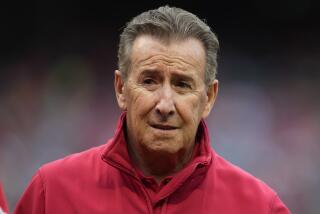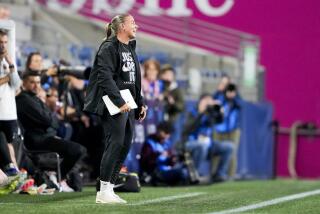Angels in the Outskirts: Far Afield in Marketing Game
There was a buzz around the Rotary Club meeting in Temecula Wednesday.
“This is big,” Rotary member David Frank said. “People have come from Murrieta . . . and Elsinore.”
The attraction? The Angels were in town, or at least a few of them. Infielders Dave Hollins and Gary DiSarcina, catcher Todd Greene and coach Joe Maddon had traveled 50-some miles, although not all were clear on the concept.
“Why are we here?” Hollins asked DiSarcina.
Baseball, Dave. Or rather, the selling of the game.
Opening day is about two months off, but the Angels are in midseason marketing form, using a mixture of high-tech Disney touches and town hall meetings to entice fans to come to their renovated stadium, now dubbed Edison International Field of Anaheim.
A group of Buena Vista Films employees has been borrowed to create an ad campaign that would make producers of any Disney animated movie proud. All that seems missing is a fast-food restaurant tie-in. Then again, can a Tim Salmon action figure with an order of fries be far off?
What this costs is undisclosed, but the Disney pockets are deep enough to cover radio, TV and newspaper spots, as well as sending players barnstorming around the Southland. Angel players will go as far as the Coachella Valley during the next week before the stadium is ready for an open house next weekend.
Disney has done this before, of course, blanketing Orange County and surrounding areas with a marketing campaign so successful that Mighty Duck products became the National Hockey League leader in merchandise sales before the Ducks had even played a game.
“From a sales and marketing standpoint,” Angel President Tony Tavares said, “you just don’t wake up one day and wave your magic wand and throw a little pixie dust around, and all of a sudden there are 3 million fans in the stands for the season.”
The Angels are following the lead of baseball teams in Baltimore, Cleveland and Texas who have made off-season marketing a priority, often after building new ballparks.
The Texas Rangers, in fact, have an even bleaker baseball history than the Angels, but got a huge bounce when their stadium opened in 1994.
“The ballpark needs to become a destination point,” said Charlie Seraphin, the Rangers’ vice president for marketing.
Wednesday’s destination for the Angels was Temecula. The players and officials later split into two groups to cover two area high schools, and reunited at a Lake Elsinore pizza parlor. They answered questions, signed autographs--on photos with 1998 Angel schedules on the back--and showed a brief video, which mostly focused on renovated stadium formerly known as the Big A.
*
The Angels have been marketed before, but not the Disney way, and certainly not with any tremendous success. The Angels have always stood knee-high to the Dodgers in the Southland, as well as being dogged by the team’s spotty past.
“It’s getting back to grass-roots marketing, getting back to the fan base,” Tavares said. “Making sure you’re out there in the community . . . getting the players out there meeting people.”
Ken Wachter, Angel vice president of sales and marketing, would say only, “We’re going to do all we can to get the word out.”
Some baseball teams contend there are easier ways to market a franchise, if you have the right ingredients.
“We market our team,” said Barry Stockhamer, the Dodgers’ vice president for marketing.
“The team is the story. In our case, we have players who, on any given day, can do extraordinary feats.
“We’re celebrating our 40th year in Los Angeles this season. No National League team has won more pennants in that time. The history of the Dodgers in Los Angeles is something we want to relive.”
The history of the Angels in Anaheim is, well. . . . Suffice to say, a campaign to relive “The Year We Blew a 3-Games-to-1 Lead to Boston” is not going to send ticket sales soaring.
Still, Anaheim Sports Inc. officials discount the Dodgers’ presence.
“There are plenty of people in Orange County,” said Spencer Neumann, director of sports planning for Anaheim Sports. “Our audience comes from Orange County, Riverside and over in Long Beach. Those are the areas we are concentrating on.”
The Dodgers drew 3,318,886 fans last season. The Angels drew 1,767,324. Both teams were in a pennant race into September.
“The Angels are always going to be in the shadow of the Dodgers,” said Richard Brown, the team’s president from 1990-96. “But they are also competing against 18 holes of golf, a day at the beach, a day at Disneyland.”
Which is why the renovated Anaheim Stadium has become such a focal point in the marketing scheme. An eight-page glossy insert that will be in newspapers this week shows a blue sky with puffy clouds and a baseball on the front. The words, “There’s a Brand New Theme Park in Anaheim . . . . “ teases a reader inside.
*
There are references to the team that claim a new attitude and aggressive style of play was put forth last year. There is some truth in that, as the Angels chased the Seattle Mariners much of the season before fading, in part, because of injuries. But the players have, so far, taken a back seat to the stadium in the big marketing picture.
This approach has been tried before and worked.
The Texas Rangers, in 1994, employed a massive marketing campaign that included personal appearances by Nolan Ryan. The team finished 52-62 that strike-shortened season, but drew 2.5 million in 62 home games.
“People want to come to a place where the hot drinks are hot and the cold drinks are cold and the atmosphere is always friendly,” the Rangers’ Seraphin said. “What makes Disneyland work year after year after year? Why do so many Southern California people, who have seen every ride and attraction, go back and ride on a It’s a Small World? Their expectations are always met.”
The Rangers, who won their first division title in 1996, finished 77-85 last season and still drew 2,945,244. The New York Yankees, who were defending World Series champions, reached the playoffs in 1997 and drew 2,580,445.
“With 40,000 seats, there should be no reason [Edison Field] shouldn’t be full every game,” Seraphin said. “The population suggests that there are more than enough people to fill every one of those seats.
“They already have carved out a small niche of people who will drive to see the team play. They need to broaden that scope and target fans with disposable incomes who want to eat some good food, buy a souvenir and watch some professional baseball in a safe environment. That’s a huge audience.”
*
Anaheim Sports was able to tap that market with the Mighty Ducks. The same tactics didn’t work when Disney bought controlling interest in the Angels in 1996. Cheerleaders and trivia contests between innings were not welcomed by baseball fans.
“It’s a different fan base than hockey,” Tavares said. “We learned that the first year we got involved. We started doing activities in the stands. We found out just how traditional the fan base is. The average fan in baseball is much older than the hockey fan.”
They will now try to convince those fans that this is all about baseball, while trying to attract new fans with such stadium gimmicks as interactive areas, live concerts in a garden setting and an outfield extravaganza beyond the center-field fence. The geysers and fireworks will go off, it’s promised, after exciting moments. Exciting Angel moments.
Needless to say, it will be a massive advertising assault because the Buena Vista team has been on board for a couple of months, according to an Anaheim Sports official.
“One of the advantages of the Walt Disney Co. is, when you find yourself in a rut or a hole, you can reach out and get some quality help,” Tavares said.
The player caravans are only the beginning.
The strategy will be how to explain a ticket price boost that may not sit well with fans. The Angels’ average price was $9.68 last season, below the major league average of $11.98, according to Team Marketing Report. This season, the Angels’ average price will be $12.25, up 27%.
Steve Physioc, the team’s television broadcaster, told Rotary Club members in Temecula that the price increases were weighted toward the new suites and seats behind home plate. He said that any seats from “first and third base out” were reasonably priced for families.
“The family sections in the outfield, right field and left field, those are great seats,” Tavares said. “I heard people ask, ‘Why would I want to watch the game from right field?’ I would watch the game from right field.
“People have got to remember that in sports today you have a higher payroll. It has to come from somewhere. You have to treat your seats almost like prime real estate. If you want beachfront property, you have to get the proper amount of money for it.”
In the end, though, no matter the spin, the stadium or the prices, it will all come back to baseball.
Said Tavares: “No one has been successful in marketing a stadium without having a decent baseball team.”
More to Read
Go beyond the scoreboard
Get the latest on L.A.'s teams in the daily Sports Report newsletter.
You may occasionally receive promotional content from the Los Angeles Times.







